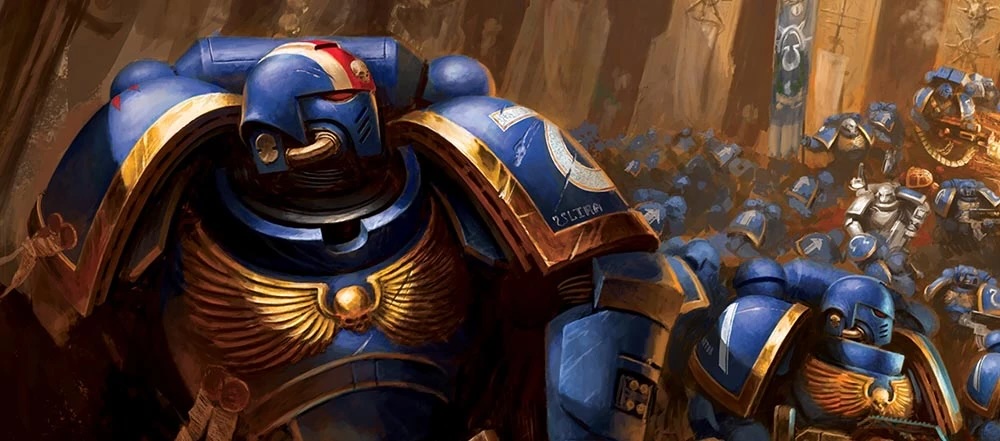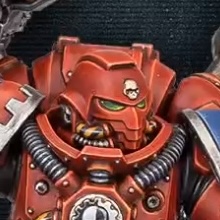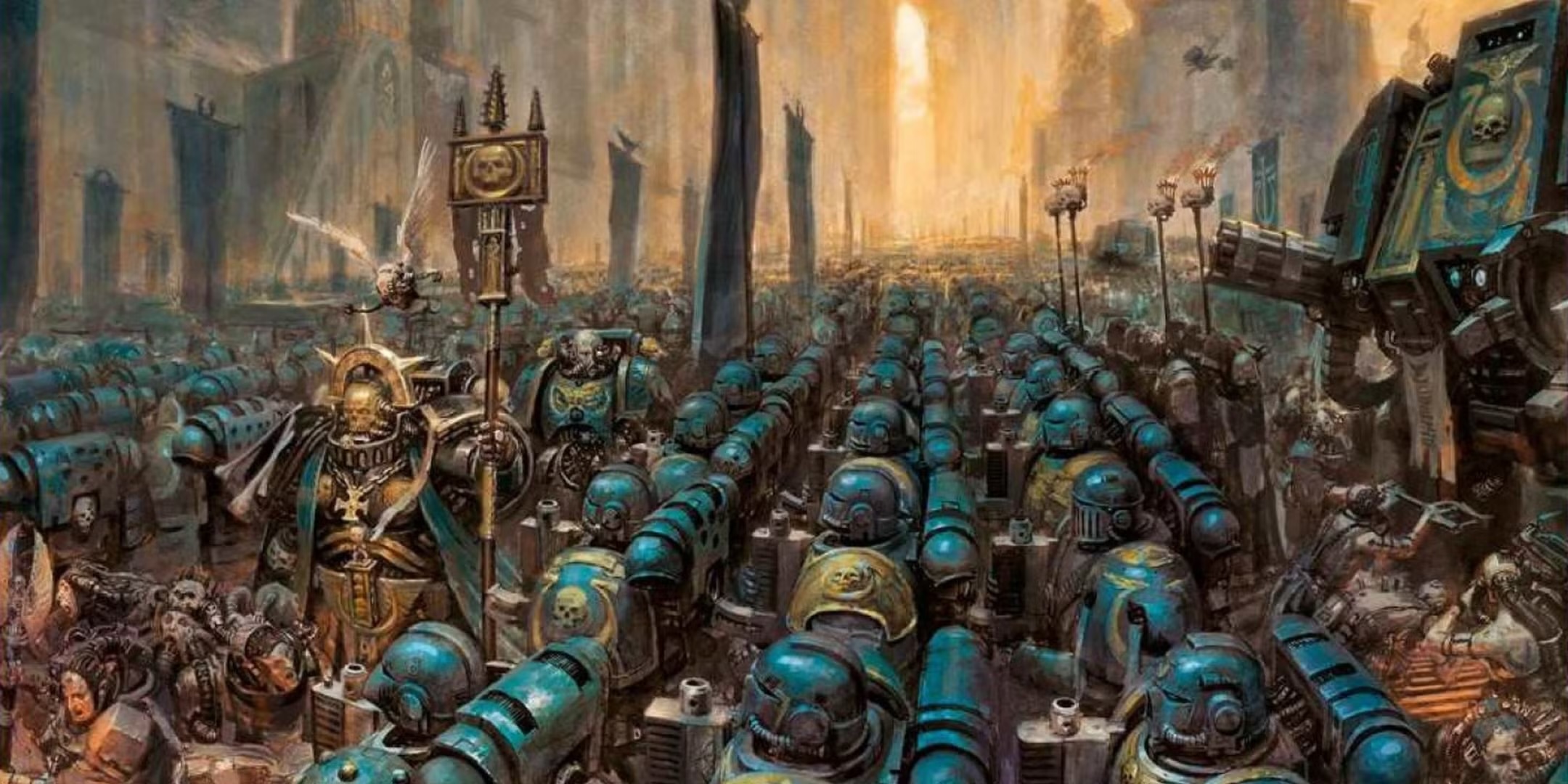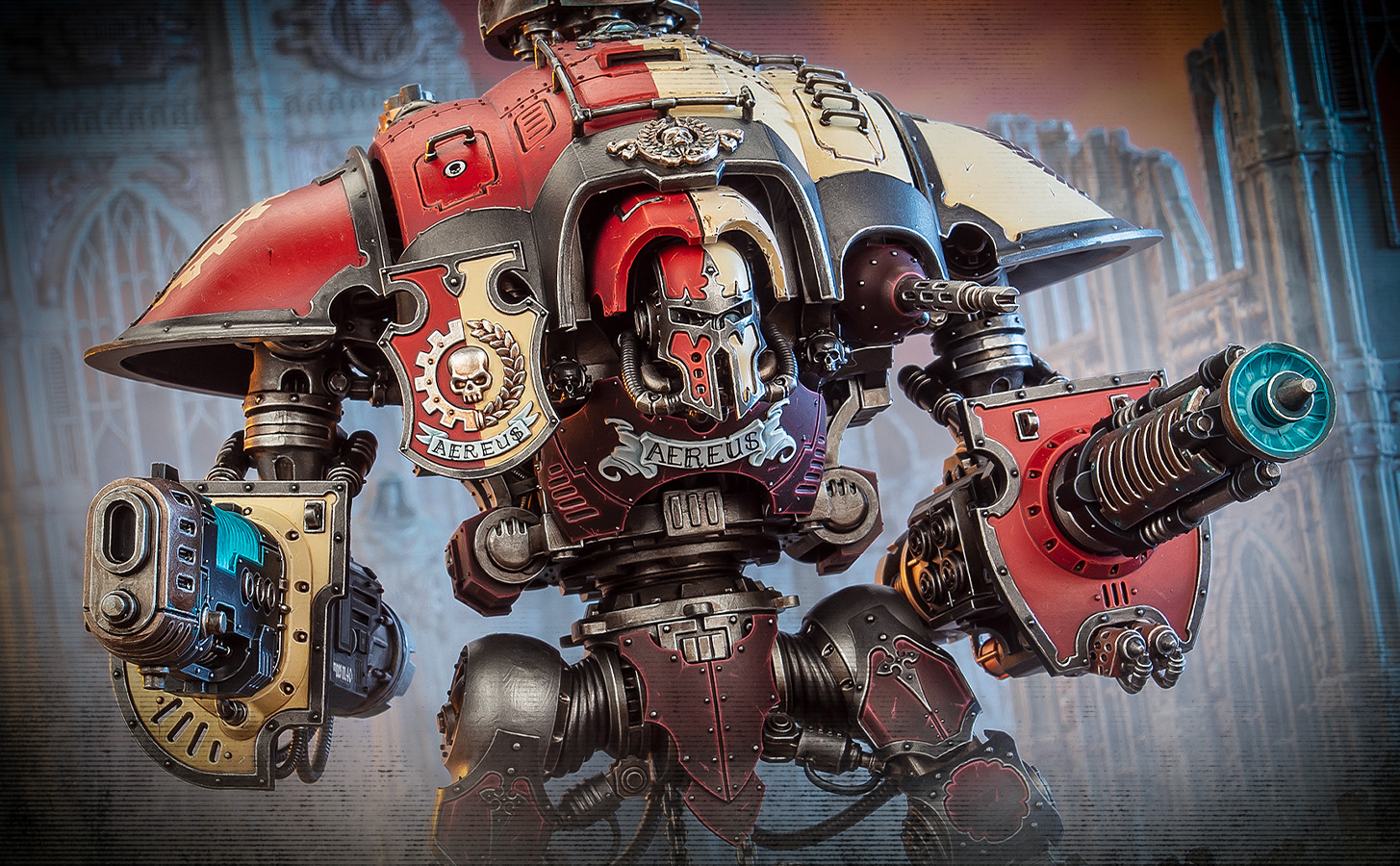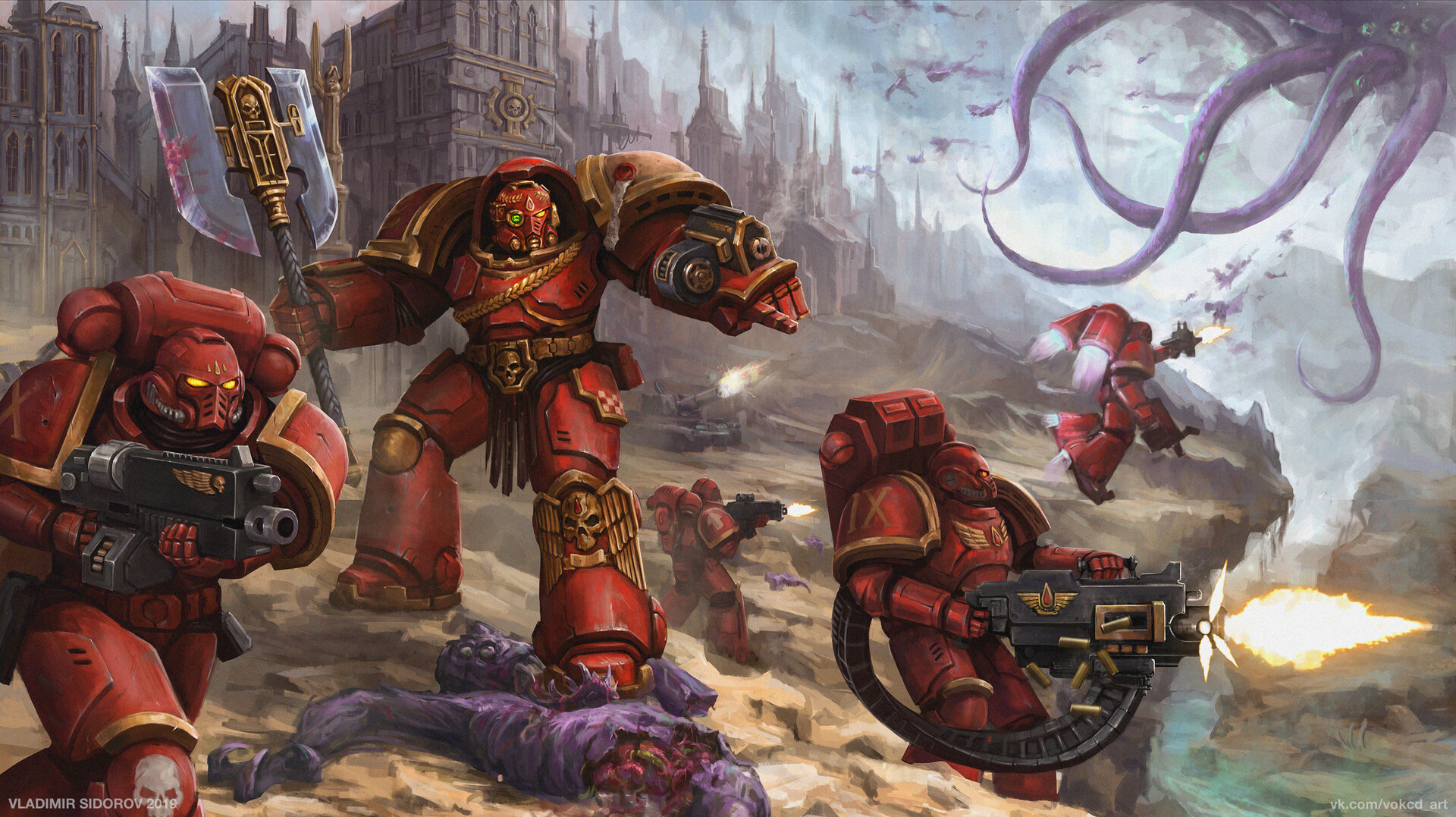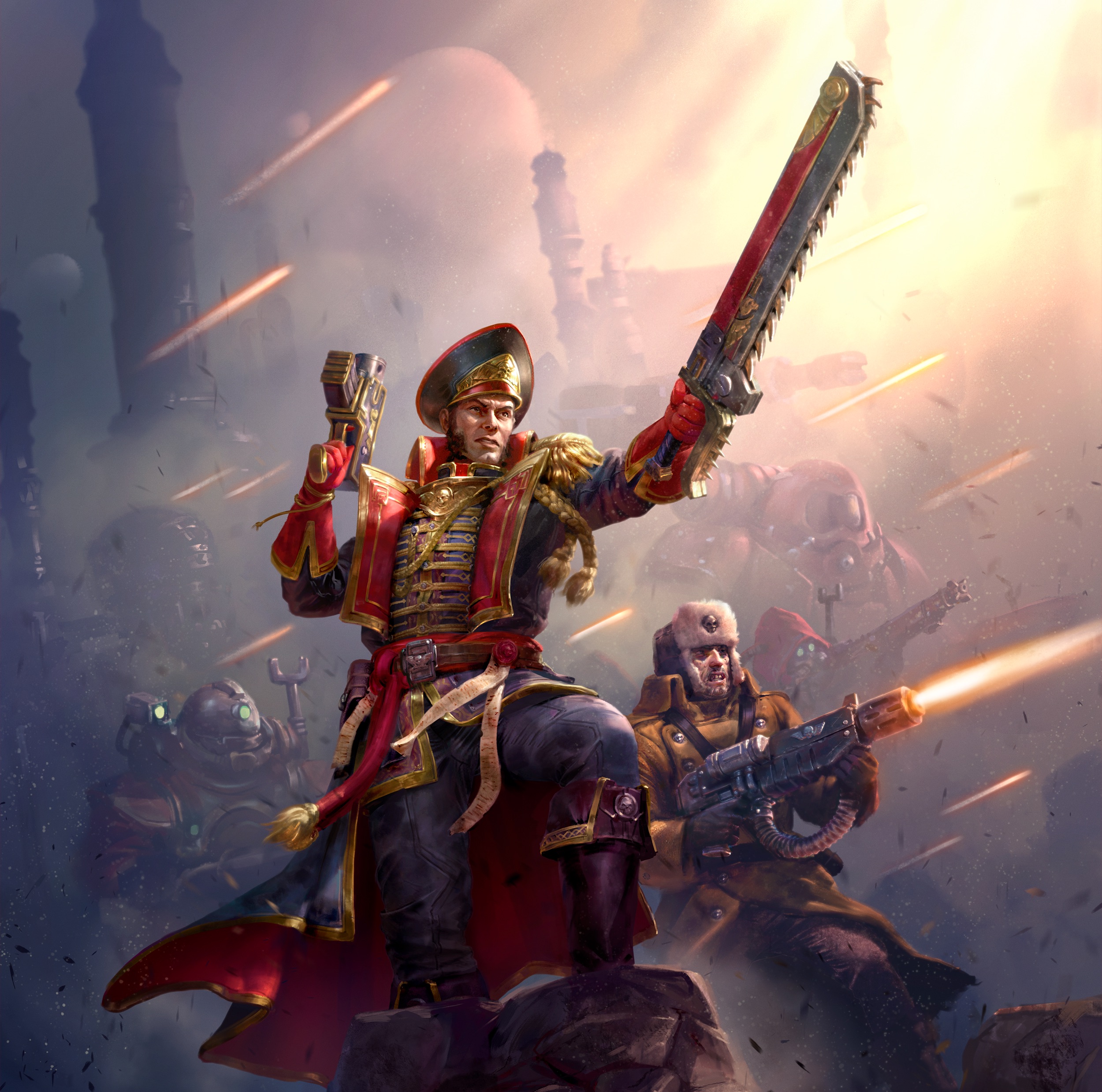“They were forged for Mankind’s darkest hour – and that hour is upon us.”
— Roboute Guilliman, Lord Commander of the Imperium
Introduction
In the grim darkness of the late 41st Millennium, as the galaxy was torn asunder by cataclysmic war, a legend returned to lead humanity from the brink of oblivion. Roboute Guilliman – the Avenging Son of the Emperor, Primarch of the Ultramarines – strode back onto the stage of history after ten thousand years in stasis.
He found the Imperium of Man besieged on all sides: the horrific 13th Black Crusade of Abaddon had shattered the Cadian Gate, and the galaxy split open with the birth of the Great Rift, a colossal warp storm that divided the Imperium in two. In this darkest hour, Guilliman unveiled a secret weapon of hope and defiance: the Primaris Space Marines, a new breed of transhuman warrior crafted to deliver the Imperium from damnation.
The announcement of the Primarch’s resurrection and the birth of the Primaris Marines spread like wildfire through the halls of Terra and across beleaguered worlds. Whispers in the Administratum spoke of gene-forged giants stepping from ancient vaults, clad in gleaming armor and bearing weapons of unreal potency. On distant battlefronts where despair had taken hold, fresh hope was kindled by rumors that the Emperor’s own son had returned with an army of mightier Space Marines at his command.
It was a moment of legend come to life: the Ultima Founding of new Space Marines chapters, and the swelling ranks of existing chapters with these enhanced warriors. Thus began a new chapter in the Imperium’s blood-soaked history, heralded by Guilliman’s words – the Primaris Space Marines had arrived, forged for humanity’s darkest hour, and that hour had indeed come.
The Creation of the Primaris
The origins of the Primaris Space Marines reach back to the aftermath of the Horus Heresy, long before their dramatic debut. In the early 31st Millennium, as the Imperium reeled from civil war, Roboute Guilliman foresaw a future crisis beyond even the Heresy’s horrors. In those desperate days following the Second Founding, Guilliman gave a secret charge to Archmagos Dominus Belisarius Cawl, a brilliant and eccentric Tech-Priest of Mars.
Cawl was tasked with an audacious project: to improve upon the Emperor’s original Space Marine design and create a new legion of transhuman warriors that could one day avert the Imperium’s next cataclysm. Guilliman entrusted Cawl with precious tools to achieve this miracle – most significantly the Sangprimus Portum, a relic said to contain genetic information from all twenty Primarchs. Armed with this vault of genomic knowledge and forbidden Standard Template Constructs, Archmagos Cawl began an endeavor that would consume ten thousand standard years.
Hidden in the red vaults deep beneath Mars, Cawl labored in secrecy and devotion. He experimented ceaselessly, splicing gene-seed, integrating ancient techno-arcana, and carefully augmenting the genetic template of the original Astartes. It was an undertaking of unprecedented scale and patience.
Across millennia, even as the Imperium forgot or never knew of his charge, Cawl tinkered and perfected. Many of his experiments doubtless ended in failure or monstrosity, but the Archmagos persisted with machine-like determination and faith in Guilliman’s vision. Over the centuries he amassed a hoard of knowledge – some won in battles against xenos, some scavenged from mankind’s own lost Golden Age – all to serve the creation of the Primaris warriors.
By late M41, as chaos and alien horrors beset humanity on all sides, Cawl’s secret work was finally complete. The Primaris Space Marines had been perfected in vitro and tested in hidden war zones. Tens of thousands of these new Astartes had been grown and gene-forged in vaults and cryo-stasis chambers aboard Cawl’s great Ark-ships and in the bio-laboratories on Mars.
Only Guilliman’s return from his own long sleep could initiate the final phase of the plan. Upon awakening, the Primarch was presented with the fruits of Cawl’s labor – the Emperor’s Angels of Death, reborn mightier than ever. Guilliman, now Lord Commander of the Imperium, authorized the grand unveiling of the Primaris. After ten millennia of secret toil, Archmagos Cawl’s triumph was at hand, and a new generation of super-soldiers stepped from myth into reality.
Differences from Firstborn Space Marines
The Primaris Space Marines represent the next evolution of the Adeptus Astartes, and their differences from the older “Firstborn” Space Marines are both physical and technological. Even to the naked eye, a Primaris Marine is a terrifying giant – standing nearly eight to ten feet tall in armour, they tower above their Firstborn battle-brothers.
Genetically and biologically, they have been enhanced beyond the limits of the original Space Marine template. Where a traditional Astartes possesses nineteen gene-seed implants, a Primaris has twenty-two. Archmagos Cawl engineered three new organs to further augment these warriors: the sinew coils (strengthening muscle fiber), the magnificat (an enhanced hormonal gland, sometimes called the “Amplifier”), and the Belisarian furnace (a unique healing and longevity organ that can flare to life when the warrior is grievously wounded).
These additional implants, combined with refined gene-seed engineered for stability and potency, make Primaris physiques even stronger, more resilient, and faster-reacting than those of the Firstborn Astartes. It is said that a Primaris Marine’s gene-seed is so stable that genetic deviation is nearly nonexistent – a vanishingly small 0.001% per generation – avoiding many of the flaws that have haunted certain chapters over the millennia. Where some Firstborn might struggle with the Black Rage of the Blood Angels or the feral curse of the Space Wolves, the Primaris are remarkably free of such afflictions, their bloodlines purified by Cawl’s artifice.
Aside from their biological supremacy, Primaris Space Marines are outfitted with the very best wargear the Imperium could devise at the cusp of the 42nd Millennium. They stride into battle encased in Mark X power armour, a brand-new pattern of ceramite battle-plate devised by Cawl himself.
The Mark X armour combines the most effective elements of past armour marks (harking back to the Great Crusade era patterns) with cutting-edge developments in power field technology. This armour offers improved protection and strength augmentation, allowing the Primaris to weather blows that might cripple a lesser Space Marine.
In their gauntleted hands, Primaris Marines carry newly crafted weapons of war: the Bolt Rifle, a longer-range, high-caliber successor to the traditional bolter, is their signature firearm. Firing mass-reactive shells with superb accuracy and stopping power, the Mark II Cawl-pattern Bolt Rifle turns a Primaris battle line into a wall of explosive death.
They also brandish specialist arms such as Plasma Incinerators, refined plasma weapons with greater output than any carried by Firstborn, and wield combat blades energized at the atomic level. Supporting the Primaris in battle are advanced new vehicles – from the Redemptor Dreadnought, a walking engine of destruction that houses a mortally wounded Primaris warrior, to anti-gravitic Repulsor tanks and Overlord gunships that skim into battle with thunderous heavy weaponry. Every facet of the Primaris arsenal was re-imagined and upgraded, giving these warriors a distinct advantage in firepower and durability on the battlefield.
Culturally and organizationally, the Primaris Marines began as something of a blank slate compared to their Firstborn counterparts. They were trained in isolation, thousands of heroes without chapter banners or battle honors at first – a brotherhood apart, known initially as the Unnumbered Sons during their early deployments.
While the Firstborn Astartes had ten millennia to diverge into unique Chapter cultures, forge traditions, and even develop quirks of gene and custom, the Primaris were unified by the cutting-edge Codex discipline drilled into them by Cawl’s techno-savants.
In the beginning, they fought as legions of mostly indistinguishable warriors, each one a product of the same rigorous forging. Over time, however, many Primaris would be integrated into existing chapters or formed into new ones, and they began to take on the colors, heraldry, and indeed the proud traditions of those legions they now called family.
Still, the term “Firstborn” entered common usage to delineate the older Space Marines from these fresh brethren. The existence of the Primaris did not render the original Space Marines obsolete overnight – instead, for a time, the Imperium fielded two iterations of the Emperor’s Angels of Death side by side. Comparisons were inevitable, and in nearly every regard the Primaris proved a superior breed of Astartes, yet bound by the same unyielding loyalty to the Emperor and their Primarchs’ gene-legacy.
The Indomitus Crusade
Guilliman did not create the Primaris simply to stand as an experiment; he unleashed them in a grand effort to save the Imperium from imminent collapse. Thus was born the great Indomitus Crusade, a colossal, multi-fleet crusade led by Guilliman himself to reclaim and reinforce the sundered realm of mankind.
It began in the wake of the Cicatrix Maledictum (the Great Rift) around 999.M41, almost immediately after Guilliman’s return to Terra. In the shadow of Holy Terra’s golden throne, Guilliman gathered the largest Imperial armada seen since the days of the Great Crusade. With him stood newly-forged armies of Primaris Space Marines – some organized into brand new Chapters of the Ultima Founding, others arrayed as unassigned cohorts under Guilliman’s direct command.
In a moment of triumph deep below the surface of Mars, the Primarch and the Archmagos together awakened tens of thousands of Primaris warriors from stasis and gave them their long-awaited purpose. No longer sleeping in hidden vaults, these warriors now bore the panoply of war and the heraldry of the Emperor’s finest.
The Ultima Founding officially created many new Space Marine Chapters entirely composed of Primaris Marines, while countless other Primaris brethren were formed into the Unnumbered Sons – huge, flexible legions that Guilliman could parcel out as reinforcements to existing chapters desperately in need.
When the Indomitus Crusade launched, it did so with the fury of a cornered lion. Guilliman’s fleets struck out across the Segmentum Solar and Segmentum Tempestus in a hundred directions, determined to stabilize the Imperium Sanctus (the half of the Imperium still directly lit by the Astronomican) and push back the tides of Chaos that had erupted from the Great Rift.
The Primaris Space Marines formed the tip of the spear in these Crusade battle groups. They were deployed to war zones that had stood on the brink of annihilation, their arrival often turning the tide where all hope had been lost.
On war-torn Rynn’s World, home of the Crimson Fists Chapter, Guilliman’s forces broke a daemonic legion that had overrun the planet; the beleaguered Crimson Fists looked on in awe as warriors bearing their own chapter’s heraldry – Primaris Marines created from Imperial Fists gene-stock – descended to fight at their side.
Some of these new warriors had been in stasis since the days of the Great Crusade itself, and a few veterans among them could even recall fighting under Primarch Rogal Dorn’s command ten millennia ago. Such living legends fighting shoulder-to-shoulder with current Astartes inspired hope and reverence in equal measure.
Meanwhile, across the galaxy at Baal, the Blood Angels and their successors were making a valiant last stand against an immeasurable Tyranid swarm. At the height of what became known as the Devastation of Baal, when all seemed lost, Guilliman’s crusade forces arrived from the warp. Drop pods streaked down and Primaris reinforcements stormed forth, their bolters and blades turning the xenos tide. The Blood Angels, saved from extinction by this timely intervention, welcomed these mighty strangers as true sons of Sanguinius, kin by blood and valor when they relieved the fortress-monastery of Baal in its darkest hour.
For twelve years of relentless warfare, the Indomitus Crusade vented its wrath upon humanity’s enemies. World by world, system by system, Guilliman’s armies beat back daemonic incursions, crushed heretical uprisings, and fortified planets that had stood defenseless.
In that time, the Primaris Space Marines earned a wealth of battle honors and proved their worth a thousand times over. Their superior gene-forged bodies and weapons made them ideal shock troops to shatter the forces of Chaos and other foes. More importantly, they brought much-needed numbers to the Space Marine forces.
Chapter Masters across the Imperium Sanctus found their ranks replenished by these newcomers, allowing them to hold territory and launch counter-offensives that would have been impossible before. Many formerly isolated or understrength Chapters received whole companies of Primaris as reinforcements, immediately tipping the balance in ongoing campaigns.
On some fronts, entire new Primaris Chapters took up permanent station to hold the ground that the crusade had reclaimed. As the Indomitus Crusade reached the successful end of its first phase – marked by the pivotal Battle of Raukos, where Guilliman’s forces finally stemmed the Chaos advance – the Imperium had been granted a reprieve from imminent collapse. Guilliman’s grand gamble had paid off: the introduction of the Primaris Marines en masse had stabilized the Imperium’s defenses, at least on one side of the rift, buying precious time in an age where every second of survival was victory.
Yet the war was far from over. As the crusade wore on, the initial stock of Primaris warriors that Cawl had prepared – those held in stasis in vessels like the Zar-Quaesitor – began to dwindle. But Cawl had anticipated this, and even as battles raged, the Archmagos moved to activate more of his secret gene-vaults and continue producing Primaris Marines to keep the momentum.
The Indomitus Crusade eventually fragmented into smaller fleets to continue the fight or respond to new crises, and Guilliman himself turned his attention to governing an Imperium in turmoil. The Era Indomitus had dawned, with the Primaris Space Marines etched indelibly into the lore of that age – as saviors on countless battlefields and heralds of a new epoch of warfare. Through fire and blood, they had proven Guilliman’s bold experiment a resounding success, giving humanity a fighting chance in the encroaching darkness.
The Challenges of Integration
While the Primaris Marines’ deeds in battle quickly became legendary, their introduction was not without controversy and turmoil within the Adeptus Astartes itself. The existing Space Marine Chapters – each with proud traditions and gene-lineages stretching back to the Heresy – suddenly found themselves asked (or ordered) to accept an influx of these “new” Marines among their ranks.
Reactions ranged from grateful acceptance to deep suspicion. Many Chapter Masters, ravaged by recent wars and desperate for reinforcements, welcomed the Primaris as long-lost brothers sent by the Emperor in a time of need. To these leaders, it was a miracle – fresh warriors who shared their gene-seed and bore their chapter colors, arriving when their Chapter’s survival hung by a thread.
On other homeworlds, however, more traditionalist and cynical voices were raised. Some Space Marines questioned the purity and provenance of the Primaris. Were they truly the sons of their Primarchs, or the unnatural tinkering of a Tech-Priest who had meddled with the Emperor’s design?
A few Chapter commanders even viewed the Primaris with hostility, deeming that the Emperor’s work should never have been tampered with by mortal science. In the halls of the Space Wolves on Fenris or the secretive inner circles of the Dark Angels, whispers of doubt spread: could these newcomers be trusted, or were they an affront to the legacy of the Allfather and the Lion?
Tensions ran high in those early days of integration. There are tales of confrontations where proud Firstborn veterans bristled at serving alongside Primaris who had not earned glory in the same blood-soaked campaigns, and of Primaris who struggled to adapt to the idiosyncratic cultures of chapters they were assigned to.
Perhaps most dramatically, it is recorded that some Chapters initially rejected outright the Primaris reinforcements and the attendant Mechanicus tech-priests who brought them, refusing to allow this intrusion into their traditions. The situation threatened to turn violent or schismatic in a handful of cases.
But Guilliman had foreseen this possibility as well and dispatched agents to smooth the process. Alongside the Primaris armies traveled representatives of the Emperor’s authority: the Adeptus Custodes, specifically a Shield Host known as the Emissaries Imperatus, golden giants who answered only to the Emperor and his regent. These Custodians made it abundantly clear that accepting the Primaris was the will of the living Emperor (as voiced by Guilliman) – and to refuse would be nothing less than treachery.
Through the artifice of the Martian priesthood were these warriors created. By the grace of the almighty Emperor are they given now to you. Silence your questions and instead rejoice at the honour done to you this day. You are handed the gift of hope by the immortal Master of Mankind Himself, and you will accept it with sincere and solemn gratitude lest you be taken for the traitors that you profess to hate.
— Emissary Imperatus Sanash Gallimedan, addressing the Hammers of Dorn Chapter
These uncompromising words, spoken by a Custodes envoy to a recalcitrant Chapter Master, echoed across the Adeptus Astartes. One does not lightly refuse a gift from the Emperor’s own hand, as the Custodians sternly reminded them. In the end, nearly all Chapters bowed to this reality. Some did so grudgingly, others with open arms, but compliance was achieved.
As records later showed, roughly 94% of existing Space Marine Chapters eventually integrated Primaris Marines into their ranks. Time and shared struggle would ease most tensions. Battle-brothers who fought and bled together on the fields of the Indomitus Crusade developed bonds of camaraderie that no amount of initial distrust could fully withstand.
The Primaris, for their part, proved themselves loyal, valorous, and fully committed to the chapter cultures they were adopted into. Crimson Fists Primaris died by the dozens to defend Rynn’s World, instantly becoming true Crimson Fists in the eyes of their peers; Space Wolves Primaris hunted the Emperor’s foes with all the ferocity and honor their sagas demanded, soon earning their place in the halls of Fenris.
Still, the process of integration was not without lingering challenges. Every Chapter had to confront practical questions: how to mesh the Primaris into their command structure, how to equip and maintain the new arms and armor, and how to preserve chapter identity when half a company might suddenly consist of warriors raised and trained off-world.
The Codex Astartes was amended by Guilliman himself to account for Primaris unit types (such as Intercessors, Inceptors, Hellblasters and more) and the inclusion of Lieutenants as a new rank, easing their absorption into standard Chapter organization. Yet, beyond logistics and doctrine, deeper concerns gnawed at the more superstitious. Would the Primaris inherit the genetic curses or blessings of their progenitors?
The Blood Angels, grateful as they were for reinforcement, watched keenly to see if their Primaris brothers would succumb to the Black Rage or Red Thirst that haunted Sanguinius’ line. The Space Wolves, too, wondered if the so-called Canis Helix – the feral mark of Leman Russ in their gene-seed – would assert itself in these new warriors.
So far, the results seemed promising: the Primaris gene-line was engineered to be robust and pure, showing no signs of the deviations that had plagued some Firstborn Chapters. Nonetheless, dissenting voices in the halls of Titan and among the Inquisition speculated on whether introducing these altered Astartes might have unforeseen consequences in the centuries to come.
Guilliman himself took steps to ensure there were limits to Cawl’s experimentation in his gift to the Chapters. The Lord Commander decreed that only gene-seed from the nine loyalist Primarchs be used for Primaris production, pointedly forbidding Cawl from tampering with genetic material from the Traitor Legions or other unknown sources.
This assurance placated many: no Primaris Blood Raven would secretly carry the blood of Magnus the Red, nor would any Primaris of the Ultramarines bear the taint of betrayers like Lorgar or Angron. (It is whispered that Cawl petitioned Guilliman to let him utilize the gene-stock of even the II and XI Legions or the Traitors, arguing that those gene-lines themselves were not flawed – only their Primarchs were – but Guilliman’s refusal on this matter was absolute.) The Primaris were to remain, as much as possible, the sons of the Emperor’s loyal gene-lines, not an amalgam of all.
Ultimately, as the crucible of war continued to test the Adeptus Astartes, the Primaris and Firstborn learned to fight as one. In most Chapters, veteran Firstborn sergeants mentored newly inducted Primaris squads, and conversely, the awe-inspiring prowess of Primaris heroes spurred their Firstborn brothers to new heights.
Some traditionalists still sneered that the Primaris were “young upstarts” or Cawl’s lab-spawned legions, but those voices grew quieter as countless war zones were saved by Primaris valor. As the Indomitus Crusade wound down and the myriad Chapters returned to their own campaigns, the integration of Primaris Marines became a fact of life in the Imperium. The Emperor’s Angels of Death had been forever transformed – larger in stature, more diverse in origins, but united in purpose.
Their Place in the Modern Era
Now, in the Era Indomitus that followed the great crusade, the Primaris Space Marines stand as an integral part of the Imperium’s defense. In just a few decades, they have reshaped the way the Adeptus Astartes wage war and bolstered the Imperium’s armies during a time of unprecedented threat.
Most Space Marine Chapters today boast a substantial Primaris complement, if they are not composed predominantly of Primaris outright. There are several ways this has come to be. Firstly, the original Primaris from the Ultima Founding were allocated across the existing Chapters (or formed into new ones), immediately strengthening those forces.
Secondly, with Mars’ arcane technologies and Cawl’s guidance, Chapters have acquired the capability to induct and transform new recruits directly into Primaris Space Marines. No longer must all Primaris be born in Cawl’s vats; a Chapter’s own Apothecaries can now implant the gene-seed and specialized organs into aspirants, creating a new generation of Primaris born of the Chapter’s homeworld and culture.
These Primaris bred from local stock are sometimes referred to as “The Indoctrinated” or simply the second generation, but in effect they are full battle-brothers, indistinguishable in loyalty and spirit from those who came in stasis pods.
Thirdly, as trust grew, many veteran Space Marines have chosen to undergo the arduous process of the Rubicon Primaris – a surgical and genetic procedure to upgrade a Firstborn Astartes into a Primaris Astartes. This process, pioneered at great risk, has claimed some lives (for it is said even a Space Marine’s physique is barely capable of surviving the implantation surgery), but it has also produced some of the greatest heroes of this new age.
Chapter Master Marneus Calgar of the Ultramarines was among the first (if not the first) to successfully cross the Rubicon Primaris, emerging from painful reconstruction mightier than ever. In his footsteps, dozens of other famed warriors have ascended: from Chapter Masters and Captains to legendary warriors like Chaplain Cassius and Shadow Captain Kor’sarro Khan, each choosing to bet their ancient lives on becoming a new kind of warrior for a new age. These ascended Primaris, sometimes called “The Ancients” or simply The Ascended, bring with them centuries of battlefield experience now wed to the improved might of the Primaris form – a potent combination indeed.
The presence of Primaris Marines in such numbers has significantly changed the Imperium’s war efforts. For one, the sheer scale of Space Marine operations has increased. Many Chapters that were on the verge of extinction have been restored to full strength or beyond. There are brand-new Chapters – such as the Rift Stalkers, Novamarines Ultima, or Silver Templars – that consist purely of Primaris Marines, standing watch over critical warp-flux zones and newly conquered territories.
Some Chapters thought lost or long disbanded have even been reborn: ancient names like the Soul Drinkers have been refounded in the Ultima Founding, given another chance to serve the Emperor in glory. The strategic flexibility afforded by these increases is enormous. In theaters of war that once could field only a single Chapter (roughly a thousand Marines) at most, one might now find two or three Chapters coordinating their strikes – or a single reinforced Chapter with both Firstborn and Primaris companies numbering far above the old limitations. Guilliman’s reorganization and the addition of lieutenants, as well as the creation of mobile Primaris-only strike forces, mean the Adeptus Astartes can respond to multiple crises with unprecedented speed and force.
Moreover, Primaris technology has gradually proliferated through the Imperial forces. The Mechanicum of Mars, having been given carte blanche by Guilliman during the Indomitus Crusade to innovate, developed many new weapons and vehicles that are now employed across the galaxy. Patterns of bolt rifles, sleek grav-tanks, and heavier battle-plate are no longer confined to the Primaris alone; they have begun to filter into the arsenals of veteran Firstborn units or specialized formations like the Deathwatch.
This melding of old and new is strengthening the Imperium’s military might at a critical juncture. For example, where once a beleaguered world might wait months for a single company of Marines to answer a distress call, it might now receive a strike force of mixed Primaris and Firstborn, deployed from a fast Vanguard cruiser, hitting far above its historical weight class.
The Torchbearer missions (also known as the Adeptus Astartes Reinforcement Waves) continue to deliver Primaris reinforcements and the means to create more, even to Chapters that were stranded on the far side of the Great Rift without access to Mars’ aid. Thus, even in the dark void of Imperium Nihilus (the half of the galaxy cut off from Terra’s light), some isolated Chapters have now received the Emperor’s gift of Primaris reinforcements to hold back xenos and Chaos foes.
In the political sphere, Guilliman’s return and the Primaris project have subtly altered the power dynamics within the Imperium. The Adeptus Mechanicus, through Cawl, demonstrated an uncanny capability to innovate beyond the ancient doctrines – a feat previously thought impossible due to the stagnation of the Machine Cult.
This has caused both hope and concern. Some within the Mechanicus question whether Cawl’s work overstepped the bounds of the Omnissiah’s will, even as others take it as proof that the Quest for Knowledge must continue. Within the Inquisition and High Lords, debates simmer about loyalty and control: the Primaris are loyal to Guilliman, but Guilliman himself walks a careful line in wielding his new armies so as not to appear a threat to the Emperor’s Throne.
Thus far, Guilliman’s motives seem pure and in line with saving the Imperium, and the Primaris Marines have exhibited the same fanatical devotion to Emperor and Empire as their Firstborn kin. But one cannot ignore that such large-scale changes to the Adeptus Astartes haven’t occurred since the Second Founding – and back then it was Guilliman who enforced the Codex to break up the Legions, fearing the concentration of too much power. Now he has effectively concentrated a great deal of power in his own person as Lord Commander with these new forces. How this will play out in the centuries to come remains a point of speculation in the shadowy corners of Imperial politics.
Looking to the future, what fate awaits the Primaris Space Marines? Many Imperial savants believe they are now essential to humanity’s survival; they will form the core of the Imperium’s defenses in this new era, perhaps eventually supplanting the Firstborn entirely as time and attrition take their toll on the older Marines. Indeed, each year sees more venerable heroes crossing the Rubicon Primaris, and fewer unaugmented neophytes joining the Chapters.
It is very possible that a century from now, the distinction between Primaris and Firstborn will fade, and all Adeptus Astartes will share the Primaris enhancements as standard. The ultimate destiny of the Space Marines may thus be to evolve fully into this new form, fulfilling what some see as the Emperor’s original intent – after all, had the Emperor continued his work on the Astartes project, might he not have eventually perfected them in the way Cawl did? This is a hopeful view, one that sees the Primaris as the salvation and renewal of the Emperor’s Angels of Death.
However, the grim darkness of the far future holds many mysteries. Archmagos Cawl remains enigmatic and active, hinting that even the Primaris represent just one step on his grand evolutionary path. Indeed, Cawl has intimated that greater projects are yet in development beyond the Primaris Marines, locked away in his mind and forge-world vaults. What these experiments might be, none can say – perhaps further augmentation of humanity’s soldiers, or entirely new kinds of warriors to face unimaginable threats.
Such possibilities make some uneasy; the line between innovation and heresy can be perilously thin in the Imperium. For now, Guilliman keeps Cawl on a leash, forbidding certain excesses (like using traitor gene-seed) and focusing his genius toward more immediate concerns (such as understanding the warp-suppressing Blackstone pylons that might help close the Great Rift). But Cawl is thousands of years old and has his own counsel – he may yet play a role in shaping the next generation of the Imperium’s defenders or its destroyers.
Conclusion
The introduction of the Primaris Space Marines has been a watershed moment in the 10,000-year saga of the Imperium. In the midst of terror and upheaval, Guilliman’s audacious gambit to unleash a new breed of Adeptus Astartes has given humanity a glimmer of hope – a chance to fight back against the dying of the light.
These warriors, born of ancient wisdom and modern desperation, have already carved their names into the chronicles of the Imperium. From the plagued battlefields of the Indomitus Crusade to the battered gates of besieged hive cities, the Primaris stand tall as the champions of humanity in an era when mankind’s flame nearly guttered out. They have not only saved countless worlds with bolter and blade, but also reignited the spirit of resistance among the Imperium’s defenders.
Yet, like all heroes of the Imperium, the Primaris Marines shoulder a heavy burden. They are the Emperor’s angels reforged, expected to do the impossible on a daily basis. The galaxy they inherit knows only war. Even as they vanquish one threat, another rises hydra-like elsewhere: Chaos warlords revel in the Great Rift’s turmoil, xenos empires press in on all sides, and nightmares unimaginable lurk in the darkness between stars.
The Primaris are mighty, but they are not invincible or infinite in number. They will be tested in battles to come in ways that even they might struggle to endure. The future remains dark and uncertain, for the enemies of mankind are legion and the wars without end. The Primaris have tilted the balance, but the long war continues unabated.
In the end, the saga of the Primaris Space Marines is still being written in blood and fire. They carry forward the legacy of the Emperor and the Primarchs – the same unyielding faith, the same superhuman courage – now amplified to new heights. If the Imperium stands a chance to see another millennium, it may well be because of the Primaris standing unbowed at the forefront of every battle, shouting defiance at the horrors that assail mankind.
In them, the dream of the Emperor’s perfect warrior lives on, refined but also tested as never before. As torch-bearers in an age of lingering night, the Primaris Space Marines fight not just to preserve what remains of humanity’s realm, but to shape its future. They have become the brightest beacon of hope on the edge of oblivion – and should that beacon falter, only darkness will remain.
In the grim darkness of the far future, the Primaris Space Marines offer a slender, shining hope that the Imperium’s story is not yet finished. They are the Emperor’s sword reborn, held aloft by Guilliman against the onrushing tide. Their victories and sacrifices will determine whether humanity’s final chapter is one of extinction or survival.
And so, with bolters roaring and blades alight, the Primaris Marines continue to wage war in the Emperor’s name – immortal heroes for a crucible of unending war, in a universe that knows only the harsh truth that there is no peace among the stars, only the glory of battle and the courage to endure.
